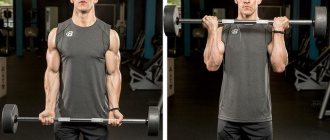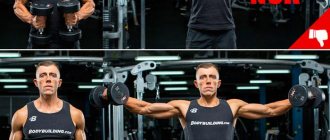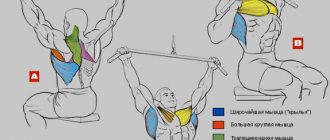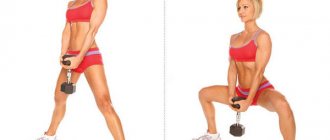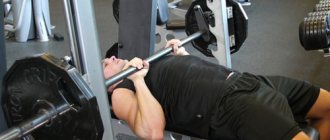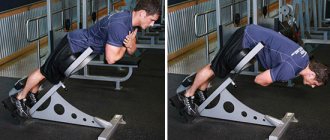Introduction
Biceps are a part of the body that many unreasonably consider to be the main one and often spend too much time training them, forgetting about other muscle groups. You can often see guys in the gym who pump their biceps two or even three times a week, stroking their pride with the misconception that “the more often you pump, the faster it will grow.” But we are not talking about them now. Here we will describe the most effective exercises for the biceps, as well as for the forearms.
In this article we will look at the muscles that are somehow involved in flexing the elbow joint. These are primarily the biceps brachii muscle (biceps), brachialis muscle (brachialis) and forearm muscles. As we already understood, biceps are needed to bend the arms at the elbows. The muscles of the forearms help with the work of the wrists. Accordingly, training the biceps and brachialis consists of all kinds of arm curls. The forearms are trained by flexing and extending the wrists.
Exercises with dumbbells
Biceps exercises are also performed with dumbbells. This is also a home option, since barbells at home take up too much space and are therefore rare, but dumbbells often gather dust somewhere in the corner.
Here are 4 biceps exercises you can do with dumbbells:
- Curling arms with dumbbells. In this case, you can sit, stand, or sit on an inclined bench at an angle of 45 degrees.
- Hammers – imitation of working with a hammer on nails. In this case, you hold the dumbbells perpendicular to the floor.
- Concentrated bicep curls are done with each arm separately in a sitting position.
Standing biceps curl
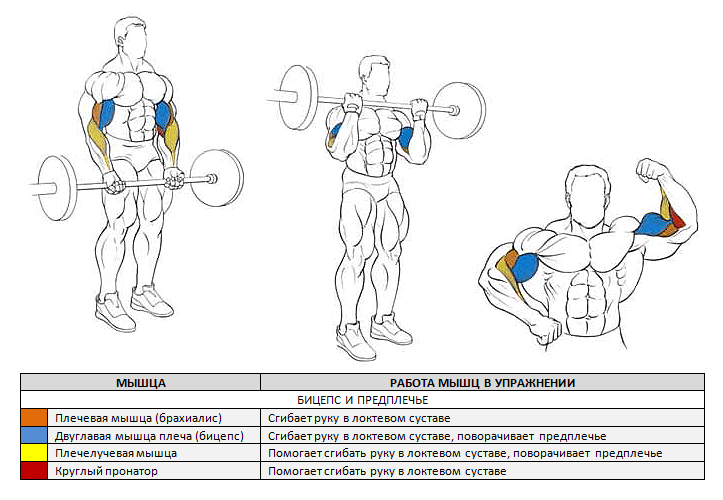
This barbell biceps exercise targets the middle, top, and bottom of the biceps, as well as the upper part of the forearm. Basic exercise, best for building mass and strength. Recommended for everyone, from beginner to experienced athlete at the very beginning of biceps training.
Exercise technique
1. Place the desired weight on the barbell. Stand straight, feet shoulder-width apart, feet parallel, toes slightly to the sides. Take the barbell shoulder-width apart with an underhand grip. 2. In the starting position, the back maintains a natural curve, the head looks forward. The arms are straightened, but not locked at the elbows. The barbell in your hands is at hip level. 3. Take a deep breath and, holding your breath, bend your elbows. At the top point, the bar should be at the level of your upper chest. 4. You can exhale after overcoming the most difficult section of the amplitude. Then immediately, without delay, lower the barbell to its original position. 5. You shouldn’t linger at the bottom point either. As soon as the bar reaches the lowest point, immediately change the direction of its movement.
Technique tips
- Using a standard shoulder-width underhand grip is the most effective way to effectively work both the biceps and brachialis.
- Using a non-standard overhand grip, shoulder-width apart, is the most effective way to effectively work the brachioradialis muscle.
- Throughout the entire approach, keep your back straight and do not sway. By pushing your body forward or backward to help lift the weight, you take the stress off your biceps.
- During the positive phase (rising), the elbows are strictly fixed at the sides. There is no need to bring them forward, otherwise the load from the biceps goes to the front deltoids.
- There is no point in using too much weight in the exercise. It will provoke you to swing and throw the barbell by inertia, which will reduce the effectiveness of the exercise.
- Too much weight will also significantly reduce the range of motion of the barbell, which will prevent you from lifting it high enough at the top.
- A variation with an angled grip is possible. For this, an EZ-bar or W-bar is used (see article). The more the hand is turned with the thumb up, the more the brachialis is activated.
- A variation with a parallel grip is possible. For this, an oval bar is used (see ibid.). In the position where the palms are facing each other, the brachialis is pumped efficiently.
- A variation is possible with an underhand grip wider than shoulder width. In the case of a straight bar, this grip allows you to effectively work the inner head of the biceps.
- A variation is possible with a grip from below, narrower than the shoulders. In the case of a straight bar, this grip allows you to effectively work the outer head of the biceps.
Weekly training program
The proposed training program is intended for beginners. If desired, you can always transform it to suit yourself. It is recommended to do training every other day.
Day 1
- Warm up,
- Deadlift 2x8,
- Bent-over barbell row 3x8,
- Pull-ups 3x10,
- Barbell curl for biceps 2x13,
- Crunches 3x20,
- Hitch.
Day 2
- Warm up,
- Squats with a 3x6 barbell,
- Leg press 2x18,
- Seated calf raise 3x15,
- Close grip bench press 2x12,
- Lifting dumbbells for biceps 1x12,
- Hitch.
Day 3
- Warm up,
- Wide grip bench press 5x5,
- Dips 3x15,
- Hammer 3x10,
- Army press 3x8,
- Hitch.
Standing dumbbell curls

This biceps exercise with dumbbells targets the middle, top, bottom, brachialis and brachioradialis muscles. This is a basic exercise used to build mass and strength. Recommended for everyone, from beginner to experienced athlete at the beginning of biceps training.
Exercise technique
1. Select dumbbells of the desired weight and hold them in both hands with a neutral grip (palms facing each other). Feet hip-width apart, back straight. The head looks ahead. 2. Take a deep breath and, holding your breath, lift the dumbbells to your shoulders. The upward movement of the dumbbells is accompanied by a turn of the hands. At the top point, the palms face the shoulders. 3. You can exhale after passing the most difficult section of the amplitude. Then immediately, without delay, return the dumbbells to their original position by turning the hands back. 4. At the bottom point of the palm, look at the side of the thigh. As soon as they reach this position, immediately change their direction of movement.
Technique tips
- Make sure to keep your elbows on the sides of your body at all times. By pushing them forward, you transfer the load to the front deltoids, which reduces the effectiveness of the exercise.
- The arms are fully straightened at the lowest point, but not to the point of locking at the elbow joints. Fully straightening the arms places stress on the elbow, which can lead to injury.
- There is no point in keeping your palms turned back in the original position. In this position, the biceps tendons become twisted and the strength of the biceps is significantly reduced.
- To maximize your biceps contraction, at the top of the exercise, try to supinate (rotate away from you) your wrist as much as possible.
- By holding your breath, you help yourself stabilize your core position, and you can develop significantly more force while lifting the dumbbells.
- Don't rock your body forward or back in an attempt to help you lift the weight. This will significantly reduce the effectiveness of the exercise.
- Do not use excessive weight in the exercise. Firstly, it will not allow you to work in full amplitude, and secondly, at the moment of turning your hand, you can injure your wrist.
- Throughout the entire approach, the hands remain motionless. Secure them at the very beginning, do not bend or straighten them.
- A variation of alternate lifting of dumbbells with the left and right hands is possible. However, with this variation, you will bend over and swing your body, which will reduce the load on the biceps.
- A variation of performing the exercise with both hands at the same time is more preferable. This way the load and center of gravity are distributed evenly, which eliminates unnecessary body movements.
Anatomical structure of the biceps
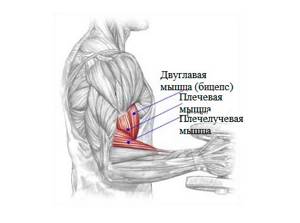
To properly pump up your biceps, you need to know how it works. First things first, its main function is to bend the elbow. Simply put, the biceps serves to bring the forearm towards the shoulder. The secondary function is supination or rotation of the hand.
And although we often think of the biceps as consisting of two parts (hence the “bi” in the name), it is actually made up of three. The main fragment that makes up the bulk of the biceps is the long and short heads. Therefore, brachialis is no less important.
The short head is on the inside of the arm. Therefore, it is often called the inner head. The short head makes up most of the mass of the arm when looking at the biceps straight on. It is more actively used when the hands are located narrower than the shoulders or directly in front of the body. This means that the best biceps exercises, like the EZ bar curl or Scott curl, will primarily target the short head.
The long head is on the outside of the arm. This is the section of the biceps that forms that very impressive mound. It is used in exercises where you keep your arms at your sides or wider. Moves like the incline biceps curl or the wide-grip biceps curl will engage the long head more. The difference in stretch when you move to the sides of your body or when you have your arms in front of you should be fairly obvious. It is this difference that determines the emphasis on one or the other head of the biceps.
Working your brachialis is like lifting your biceps up. Chances are you don't do this enough and often forget about it. Still, if you want to look your best, it's something you need to keep in mind. The brachialis is located on the outside of the arm between the long head of the biceps and the lateral head of the triceps. This muscle is best activated if the hand is in a vertical or neutral position. He trains best with hammer grip curls.
Among other things, this helps to pump up the forearm, since this position also engages the brachioradialis muscle on the upper side of the forearm. It will take a long time before this muscle begins to be visible, but for everyone who understands this at least a little, the sleeve outlines a powerful tuberous brachioradialis.
Now that you understand the structure of the biceps, it's time to get to work. Using any of these techniques will give you arms as wide as a valley and as powerful as a mountain.
Seated dumbbell curls
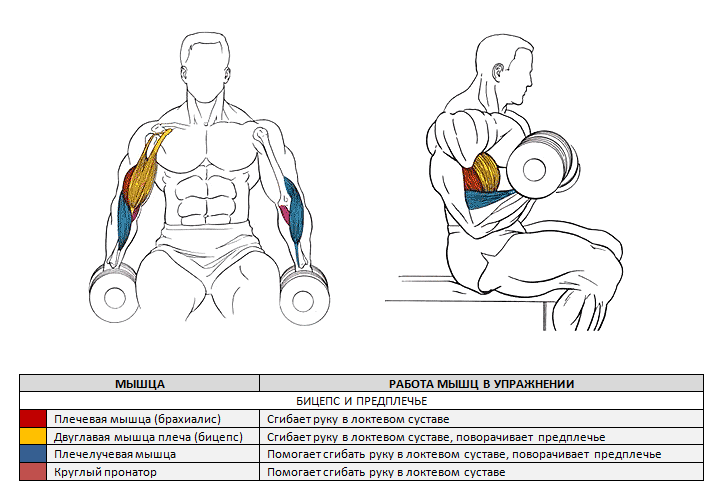
This biceps exercise targets the middle, brachialis, and brachioradialis muscles. A formative exercise, used to build strength and thicken the shape of these muscles. Recommended for everyone, from beginner to experienced athlete in the middle of a biceps workout.
Exercise technique
1. Select dumbbells of the desired weight and hold them in both hands with a neutral grip (palms facing each other). 2. Sit on the edge of the bench. In the starting position, legs are hip-width apart, feet are parallel, and the back is straight. The head looks ahead. 3. Take a deep breath and, holding your breath, lift the dumbbells to your shoulders. The upward movement of the dumbbells is accompanied by a turn of the hands. At the top point, the palms face the shoulders. 4. You can exhale after passing the most difficult section of the amplitude. Then immediately, without delay, return the dumbbells to their original position by turning the hands back. 5. At the bottom point, the palms face each other. As soon as they reach this position, immediately change their direction of movement.
Technique tips
- Do not sit across the bench, otherwise the dumbbells will touch the bench at the bottom point and you will not be able to fully extend your arms.
- Don't lean forward or sway. All movement occurs exclusively at the elbow joint. Keep your back locked throughout the entire approach.
- Holding your breath while doing the exercise not only helps you stabilize your position on the bench, but also helps you develop significantly greater force.
- The elbows are fixed at the sides throughout the entire approach. By raising your elbows at the top of the dumbbell movement, you transfer the load from the biceps to the front deltoids.
- Lifting dumbbells at the same time is preferable to alternate lifting. This way the load and center of gravity are distributed evenly, which eliminates unnecessary body movements.
- Don't use dumbbells that are too heavy. They will not allow you to lift the dumbbells to their full amplitude, which will significantly reduce the effectiveness of the exercise.
How fast does biceps grow during normal training?
Muscles grow from many different factors:
- Lifestyle;
- Diet;
- Features of the figure;
- Age;
- Training intensity.
As an example, let's take a person with a height of 180 centimeters and a weight of 80 kilograms. We focus not only on biceps, but also on muscle mass of the body in general:
- In the first six months of training, the body adapts to the load. During this time, athletes learn the technique of performing exercises. In about 3 months, the body will noticeably begin to increase.
- After the first year, muscle mass will develop and outsiders will notice the results. During this time, with the right approach, about three kilograms of muscle are added.
- After three years of training, the volume of the biceps should grow by another 5-7 centimeters.
- After five years, the hands and other parts of the body grow the worst. At best, the increase will be 5%.
Dumbbell curls at an angle
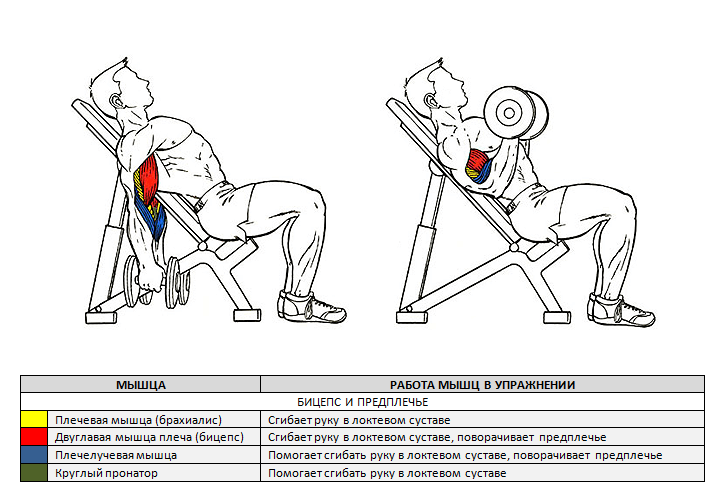
This exercise for the biceps muscles involves the middle and lower part of the biceps, the brachialis and the brachioradialis muscle. A formative exercise, used to build strength and thicken the shape. Recommended for advanced and more experienced athletes in the middle of a biceps workout.
Exercise technique
1. Select dumbbells of the desired weight and hold them in both hands with a neutral grip (palms facing each other). 2. Adjust the backrest to an angle of 45 degrees and sit on the bench. In the starting position, legs are hip-width apart, feet are parallel, and the back is straight. The head looks ahead. 3. Take a deep breath and, holding your breath, lift the dumbbells to your shoulders. The upward movement of the dumbbells is accompanied by a turn of the hands. At the top point, the palms face the shoulders. 4. You can exhale after passing the most difficult section of the amplitude. Then immediately, without delay, return the dumbbells to their original position by turning the hands back. 5. At the bottom point, the palms face each other. As soon as they reach this position, immediately change their direction of movement.
Technique tips
- To prevent you from sliding down the bench while lying down, also raise the saddle of the machine to a slight angle.
- If the raised saddle forces you to spread your legs wide and this interferes with the movement of the dumbbells, lift your legs off the floor and cross them together on the saddle.
- Holding your breath in this position is extremely important, since lifting your legs off the floor will help stabilize your body on the bench as much as possible.
- Do not swing your arms or throw dumbbells by inertia. All movement occurs exclusively in the elbow joints, the rest of the body is motionless.
- The elbows are fixed at the sides throughout the entire approach. By raising your elbows at the top of the dumbbell movement, you transfer the load from the biceps to the front deltoids.
- Lifting dumbbells at the same time is preferable to alternate lifting. It allows you to eliminate body movements and concentrate as much as possible on contracting your biceps.
- Don't use dumbbells that are too heavy. They will not allow you to lift the dumbbells to their full amplitude, which will significantly reduce the effectiveness of the exercise.
REVERSE GRIP PULL-UPS
EXERCISE TECHNIQUE - an exercise that does not require special equipment, to perform it you only need a horizontal bar, grab it with a reverse grip, pull yourself up to the level of your chin and slowly lower yourself, almost completely straightening your arms, leaving a slight tension in your biceps. Do not allow the body to swing, otherwise the amplitude will make the exercise easier and the biceps will receive less load.
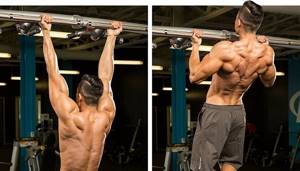
TIPS - for those who can perform more than 12 times, hang a pancake on your belt, and for those who cannot pull yourself up, first put a stool, pull yourself up a little with your legs while standing on it, and lower yourself solely using your own body weight.
Dumbbell bicep curl “Hammer”
This exercise for biceps with dumbbells involves the lateral part of the biceps, brachialis and brachioradialis muscles. A formative exercise, used to thicken the biceps and forearm. Recommended for everyone, from beginner to experienced athlete in the middle of a biceps workout.
Exercise technique
1. Select dumbbells of the desired weight and hold them in both hands with a neutral grip (palms facing each other). Feet hip-width apart, back straight. The head looks ahead. 2. Take a deep breath and, holding your breath, lift the dumbbell to your shoulder. The upward movement of the dumbbell should not be accompanied by any rotation of the hand. At the top point, the palm remains in the same position. 3. You can exhale after passing the most difficult section of the amplitude. Then immediately, without delay, return the dumbbell to its original position at hip level. 4. At the bottom point, the palms face each other. As soon as one dumbbell returns to the starting position, immediately begin moving up with the other dumbbell.
Technique tips
- Make sure to keep your elbows on the sides of your body at all times. By lifting them forward, you transfer the load to the front deltoids, which reduces the effectiveness of the exercise.
- The arms are fully straightened at the lowest point, but not to the point of locking at the elbow joints. Fully straightening the arms places stress on the elbow, which can lead to injury.
- By holding your breath, you help yourself stabilize your core position, and you can develop significantly more force while lifting the dumbbells.
- Don't rock your body forward or back in an attempt to help you lift the weight. This will significantly reduce the effectiveness of the exercise.
- Do not use excessive weight in the exercise. It will not allow you to work at full amplitude, which will significantly reduce the effectiveness of the exercise.
- Throughout the entire approach, the hands remain motionless. Secure them at the very beginning, do not bend, straighten or unfold them.
- A variation of the exercise with both hands at the same time is possible. It allows you to eliminate unnecessary movements of the body and concentrate as much as possible on bending your arms.
Dumbbell curls (different grips)
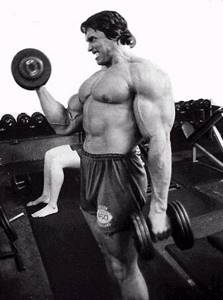
The exercise is additional, finishing. With this exercise you will be able to finally refine the muscle exhausted by lifting the barbell. This exercise can be performed standing or sitting. Different rotations of the brushes are also possible. Turning the hands helps redistribute the load on different muscle bundles of the biceps.
- To start performing the exercise, you need to determine the position of the body when performing it: sitting or standing. To perform standing, you only need dumbbells. To perform while sitting, use dumbbells and a bench.
- The mechanics of performing the exercise is to bend/extend the arms in a vertical plane. The arms at the starting point are located along the body, palms facing each other. At the top (end) point they are close to the chin. You can perform arm curls at the same time, or alternately. Depending on which beam the load is directed to, at the top point of the arm you do/don’t rotate the hand.

The exercise consists of 1 warm-up approach and 3 working sets. The warm-up approach is done with 60-70% of the working weight. Number of repetitions in warm-up and working approaches: 10-12.
For a visual representation of how to perform the exercise correctly, watch the video below:
Exercises for the chest. Dumbbell bench press.
EZ-barbell curl on Scott bench
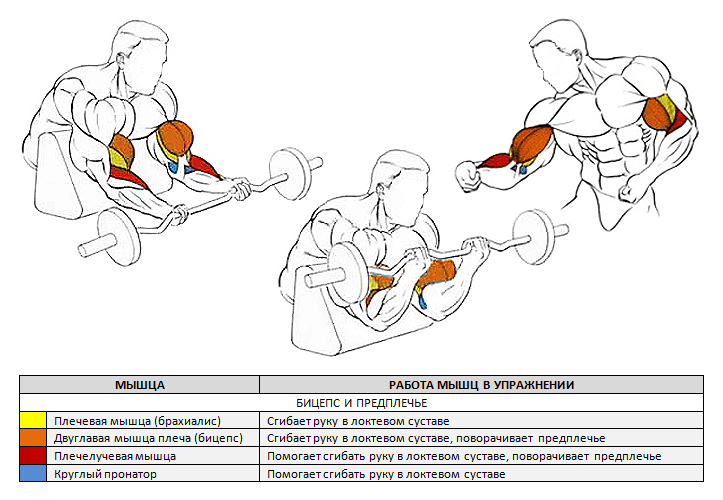
This biceps exercise with a barbell targets the middle and bottom. An isolating exercise, used to lengthen the lower part of the biceps and raise its peak. Recommended for athletes of intermediate level and above in the middle of a biceps workout.
Exercise technique
1. Adjust the height of the desk so that its upper edge rests against your armpits, your back is straight, and your body position remains fixed throughout the entire approach. 2. Take an EZ bar (or W bar), place it on the bench supports and collect the desired weight on it. Hold the barbell shoulder-width apart. Sit down so that your triceps are pressed firmly against the desk. 3. In the starting position, the back is straight, the elbows are on the desk, the arms with the barbell are straightened, but not to the point of locking in the elbow joints. 4. Take a deep breath and, holding your breath, lift the barbell up. At the top point it should be at chin level. 5. You can exhale after overcoming the most difficult section of the amplitude. Then immediately, slowly, return the bar to its original position. 6. At the bottom point, the arms are fully straightened again, and the barbell changes its direction of movement without delay.
Technique tips
- Throughout the entire approach, your elbows should be pressed tightly to the desk. By tearing your elbows off, you severely overload the joints, which can lead to injury.
- Make sure that at the lowest point your arms do not extend until your elbow joints lock. Locking is dangerous not only for the elbows, but also for the biceps ligaments.
- Holding your breath while performing the exercise helps not only keep your back straight, but also develop significantly greater force while lifting the barbell.
- Keep your body still throughout the entire approach. Adjust your seat and desk so that you don't have to lift your butt off the bench or your elbows off the desk.
- If possible, use a Scott bench to perform the exercise while standing. This way you can better fix your posture and avoid unnecessary body movements.
- To maximally work out your biceps, you can pause for literally 1-2 seconds when passing the most difficult section.
- Variations of the exercise with different bars are possible (see article). For the most versatile muscle development, change the bars periodically.
FOREARMS
In addition to the biceps and triceps, the arm consists of the forearm. Many people are crazy about the question of how to pump up their forearms. Therefore, in this issue we will also talk about this now.
In general, I do not recommend that you dwell on this issue. Because if your goal is hypertrophy (muscle growth in general), then you do not need to specifically train your forearms separately. When training large muscle groups (chest, back, legs), small muscle groups (biceps, triceps, shoulders, forearms) will also work. Therefore, think better about the growth and strength of large muscle groups, and small groups will have no choice but to GROW over time, and they will grow on their own!
Take my word for it, it will happen. Even when you just train your biceps, for example, do a barbell curl, your FOREARM IS ACTIVELY WORKING! This is already enough for their growth.
And yet, if you are fixated on this issue, then the main exercises for developing the forearm are:
- Barbell curl
- Reverse grip barbell curl
- Curls with a barbell at the wrists
Okay, we’ve sorted that out, now we’ll talk about how to organize the CORRECT ARM training!
Scott Bench Dumbbell Curls
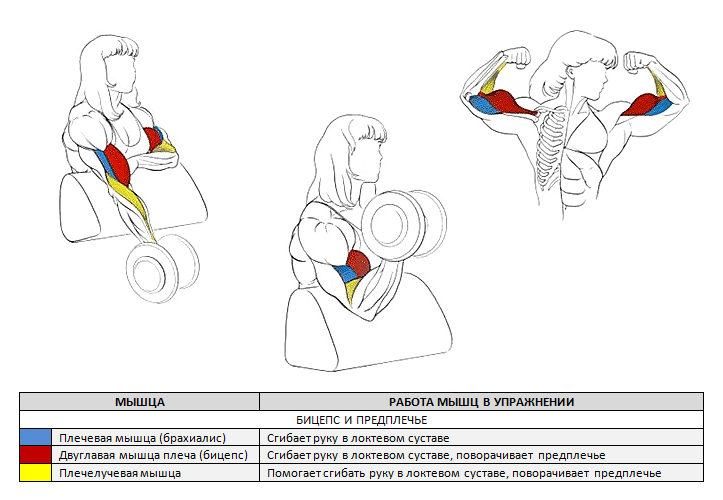
This biceps exercise targets the middle and bottom of the biceps. An isolating exercise, used to highlight the lower part of the biceps and its peak. Recommended for advanced and more experienced athletes to complete their biceps training.
Exercise technique
1. Adjust the height of the desk so that its upper edge rests against your armpit, your back is straight, and your body position remains fixed throughout the entire approach. 2. Take a dumbbell of the desired weight and place one hand so that the triceps are pressed firmly to the desk. 3. In the starting position, the back is straight, the elbow lies on the desk, the arm with the dumbbell is straightened, but not to the point of locking in the elbow joint. The palm faces up. 4. Take a deep breath and, holding your breath, lift the dumbbell up. At the top point it should be at chin level. 5. You can exhale after overcoming the most difficult section of the amplitude. Then immediately, slowly, return the dumbbell to its original position. 6. At the bottom point, the arm is fully straightened again, and the dumbbell changes its direction of movement without delay. 7. After completing all repetitions for one arm, proceed to perform the exercise with the other arm. This will be one approach.
Technique tips
- Throughout the entire approach, the elbow should be pressed tightly to the desk. By tearing your elbow off, you put a lot of stress on the joint, which can lead to injury.
- The elbow should always be pointed straight down. If it is directed inward or outward, there is a possibility of dislocating the joint.
- Make sure that at the lowest point the arm does not extend until it locks in the elbow joint. Locking is dangerous not only for the elbow, but also for the biceps ligament.
- Holding your breath while performing the exercise helps not only keep your back straight, but also develop significantly greater force while lifting the dumbbell.
- Keep your body still throughout the entire approach. Adjust your seat and desk so that you don't have to lift your butt off the bench or your elbows off the desk.
- If possible, use a Scott bench to perform the exercise while standing. This way you can better fix your posture and avoid unnecessary body movements.
- To maximally work out your biceps, you can pause for literally 1-2 seconds when passing the most difficult section.
- Do not twist or bend your wrists while raising or lowering the dumbbell. This can cause a wrist dislocation.
- The option of performing the exercise with both hands at the same time is more preferable. This way you stabilize the position of the body and eliminate unnecessary body movements.
- Variations of the exercise with different grips are possible. Turning the hand upward with your thumb shifts the load on the brachialis. Turning the hand palm down loads the brachioradialis muscle.
- A variation of the exercise on the back side of the desk is possible. But be careful. In this position, the arm will hang freely, which can lead to excessive extension at the elbow.
Basic principles of biceps pumping
The most basic aspects that must be followed in strict order. Competent biceps training follows these principles:
- Mandatory adherence to the order of exercises. There are only two truly basic exercises for biceps. This is a curl with dumbbells and a barbell. Perform these two exercises at every biceps workout without fail.
- Light weights. Yes, that's exactly it! If your working weight increases slowly on the barbell, don’t worry, the biceps is one of the smallest muscles, and therefore your working weight will be relatively small.
- Number of repetitions. The biceps is a small muscle; it doesn’t like heavy weights (by no means small ones), as well as pumping, which can be achieved with a large number of repetitions and high intensity. At the same time, with all this, try to do the exercises correctly without cheating.
- You should definitely work out other muscle groups and don’t forget about basic exercises. Our body grows proportionally, and if you only train your biceps, your muscle mass will hardly increase.
- As always, you should follow the progression of loads that we mentioned above. If increasing the weights at the initial stage will be given, then it is worth moving on to the number of repetitions per approach.
Is it possible to pump up your biceps at home? If you have barbells, weights and dumbbells, then, of course, you can, but what if you don’t have them? That should be replaced with improvised means, for example, a briefcase full of books, but somehow it doesn’t look very sporty. Don't limit yourself to two dumbbells; you'll get used to the weight of the muscle. If you study at home for a long time, you may get a result, but not as much as you can achieve in the gym during this time. And remember what we said above about the fact that it is necessary to develop muscle mass throughout the body, and not just one muscle. Therefore, you should never develop only one muscle group. If you are pumping, then you should not stop at one biceps. How many people can you remember who only have pumped up their biceps? The body develops symmetrically. Of course, one hand may be larger than the other, but it is not a significant difference. Personally, I can only remember one amwrestler, who has only one arm developed. He is the German arm wrestling champion. It is common for the body to transform completely, not individually. By pumping one muscle group, you slow down your development.
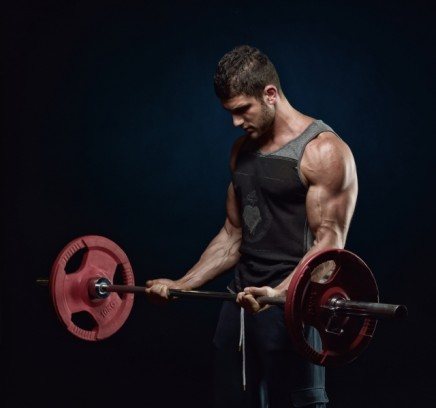
Another favorite and popular question not only for beginners, but even for experienced athletes. How to pump up the peak of your biceps? Or how it is often formulated under the question “how to pump up the biceps peak like Arnold?” Firstly, everything depends on drying. Only after you have dried do you look at the peak. But even if after this the peak did not appear or the appearance was not as impressive as Arnold’s, then this is your genetics. And all sorts of exercises on the Internet, supposedly for the peak of the biceps, are a simple lure for visitors to their own website.
This is where we end, we have considered the question of how to pump up biceps correctly or the main principles of pumping it up. We hope that the article will be useful to you.
Concentrated biceps curl
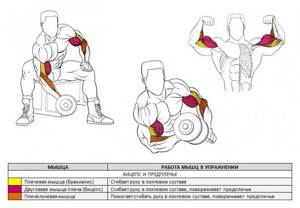
This biceps exercise with a dumbbell targets the middle and bottom. An isolating exercise, used to give the biceps a peak shape. Recommended for advanced and more experienced athletes to complete their biceps training.
Exercise technique
1. Sit on the edge of a bench and hold a dumbbell in one hand. The back is straight, legs are spread wide, feet rest on the floor. 2. In the starting position, bend over and rest the triceps of your working arm on your leg so that the arm is straightened, but not to the point of locking at the elbow. Place your other hand on your other leg. 3. Inhale and, holding your breath, lift the dumbbell up. At the top point, the dumbbell is at the level of the top of the chest. 4. You can exhale after overcoming the most difficult section of the amplitude. Then you can immediately, without delay, return the dumbbell to its original position. 5. At the starting point, the arm is fully straightened again. As soon as the dumbbell lowers to the starting point, immediately change the direction of its movement. 6. Having completed the required number of repetitions for one hand, transfer the dumbbell to the other and repeat all the above steps. This will be one approach.
Technique tips
- The triceps of the working arm should be pressed tightly against the leg, otherwise you will dangle your arm, throw the dumbbell by inertia, and significantly reduce the effectiveness of the exercise.
- Make sure that at the lowest point the arm does not extend until it locks in the elbow joint. Locking is dangerous not only for the elbow, but also for the biceps ligament.
- Holding your breath while performing the exercise will help maintain the natural curve of the spine and develop significantly greater force.
- Don't rock your body by leaning too far forward or back in an attempt to help you lift the weight. This will significantly reduce the effectiveness of the exercise.
- Do not use excessive weight in the exercise. It will not allow you to work at full amplitude, which will significantly reduce the effectiveness of the exercise.
- To engage all three muscles involved in curling the arm: biceps, brachialis, brachioradialis, perform the exercise while holding the dumbbell with your palm facing you.
- To target your biceps, start the movement with your palm facing you and then turn your hand so that at the top point your thumb is pointing away from you.
Isolation exercises
Their goal is to refine individual beams, giving them relief and mass.
Isolation exercises should be performed after the main biceps workout, with high repetitions (10-30) and light weights.
Standing barbell lift with reverse grip
This exercise is performed to refine the brachioradialis muscle and give a load to the wrist flexors. It adds volume to the forearms, the head of the biceps is weakly loaded, but by loading the internal muscles, it lifts the external ones. Will help improve the bench press, where reliable hand position and grip are important.
The technique is similar to that of a regular barbell lift, but
- the grip is carried out from above (in the lower position of the barbell, the palms are directed towards you).
- When lifting the barbell, your hands should always be straightened in line with your forearm, otherwise there is a risk of injury.
Lifting the barbell on a Scott bench
Isolates the heads of the biceps, virtually excluding all other muscles. This exercise is the best for forming the “peak” of the biceps.
Technique
- Set the angle on the bench to 70-80 degrees.
- Take the barbell in your hands, take a deep breath.
- Slowly, without jerking, lift the barbell, holding it in the upper position.
- Exhale, calmly lower the barbell, straightening your arms completely.
- It is very important to perform the exercise in full amplitude, lower the barbell all the way down. Otherwise, the lower part of the biceps will not receive peak load.
Biceps curl on a block machine
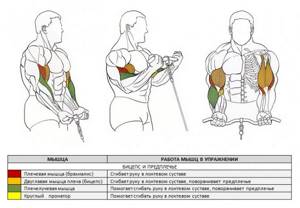
This biceps exercise targets the middle and bottom of the biceps, as well as the top of the forearm. An isolating exercise, used to highlight the clear shape of the biceps. Recommended for advanced and more experienced athletes to complete their biceps training.
Exercise technique
1. Stand facing the pulley machine. Attach a straight or curved handle to the cable of the lower block. It is desirable that it rotates freely around its axis. 2. Set the required weight on the machine. Grasp the bar at shoulder width or slightly narrower than shoulder width. Stand half a step away from the lower block so that the cable is taut. 3. In the starting position, your back maintains a natural curve, your feet are hip-width apart, your toes are parallel. The arms are fully straightened, but not to the point of locking at the elbow joints. 4. Take a deep breath and, holding your breath, bend your elbows. At the top point, the bar should be at the level of the top of the chest. 5. You can exhale after passing the most difficult section of the amplitude. Then, without delay, immediately return the bar to its original position. 6. As soon as the bar reaches the bottom point, immediately change the direction of movement and start a new repetition.
Technique tips
- You need to stand as close to the exercise machine as possible. The further you move, the greater the angle of the cable, which shortens the range of motion and reduces the effectiveness of the exercise.
- Throughout the entire approach, lock your elbows and keep them motionless. By bringing your elbows forward and engaging them in work, you take the load away from your biceps.
- Maintain an upright body position. Try not to lean your body forward or arch backward as you help yourself lift the weight. This reduces the effectiveness of the exercise.
- Holding your breath helps not only to stabilize the position of the body, but also to develop a much more powerful force in the positive phase (lifting).
- All movements, both in the positive (lifting) and negative phases (lowering), are performed at a moderate pace. By throwing or throwing weights, you reduce the effectiveness of the exercise.
- Significant weight in the exercise is useless. It will not allow you to work at full amplitude. Learn the technique and only when you perfect it, increase the weight.
- At the bottom of the exercise, try not to straighten your arms until the elbow joint locks. This blockage can injure the biceps joint and ligaments.
- Variations of the exercise with different handles are possible (see article). For comprehensive development of the muscles involved in bending the arms, periodically change your grip.
- It is possible to perform the exercise alternately with one hand and then with the other. The single handle allows you to work each hand separately.
- A variation of the exercise while lying on the floor is possible. By locking your elbows into the floor, you can isolate your biceps and increase the effectiveness of the exercise.
- A variation of the exercise with a Scott bench is possible. You place the bench in the machine in front of the lower block and perform the exercise. This will also isolate the biceps.
Crossover biceps curls
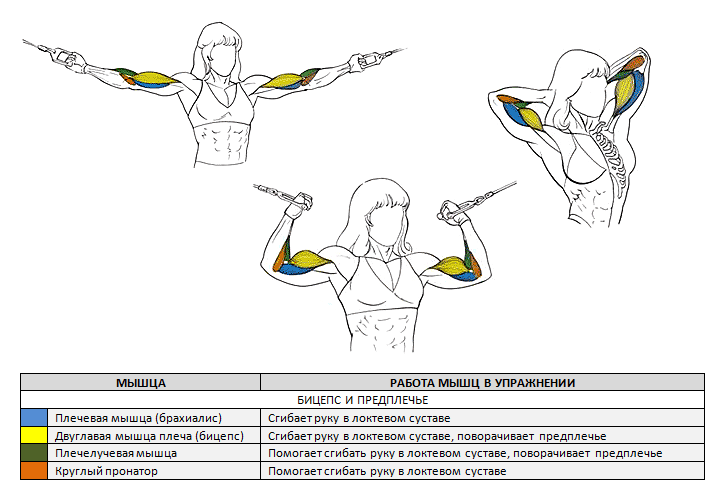
This exercise for the biceps muscles involves its middle and peak. An isolating exercise, used to lift and tighten the peak of the biceps. Recommended for advanced and more experienced athletes to complete their biceps training.
Exercise technique
1. Attach the single handles to the crossover upper pulley cables. Stand in the center of the machine and grasp the handles with your palms facing up. 2. In the starting position, your back maintains a natural curve, your legs are hip-width apart, your feet are parallel. The arms are straightened and slightly bent at the elbows, the cables are taut. 3. Inhale and hold your breath, bend your elbows. At the top point, the handles should be as close to the head as possible, at shoulder level. 4. You can exhale after passing the most difficult section of the amplitude. At this moment, immediately and smoothly return the handles to their original position. 5. At the moment of full straightening of your arms, do not linger and immediately change the direction of their movement.
Technique tips
- For maximum contraction of the biceps, brachialis and brachioradialis muscles, which cause the peak of the biceps to grow upward, keep your arms and elbows stationary.
- Stand clearly in the center of the machine so that the load is distributed evenly on both hands. Perform the movement with both hands at the same time and slowly.
- A variation with performing this kind of bending with one hand is not very effective. This will make it quite difficult to maintain a stable body position.
- Holding your breath while performing the exercise allows you to significantly stabilize the body and concentrate on bending your arms.
- If the design of the simulator allows you to move the blocks in height, install them 30 cm above shoulder level. This will achieve maximum contraction of the biceps.
- If the design of the simulator allows you to move the blocks in height, perform the exercise while sitting. This will strengthen your core and increase the effectiveness of the exercise.
- Placing your elbows at shoulder level focuses the load on the middle portion of the long head of the biceps. This will allow you to maximally pump the peak of the biceps brachii muscle.
- Do not rotate your hands while moving. They should be firmly fixed throughout the entire approach in one position - palms up.
- To maximize contraction of the biceps, it is allowed to slightly bend your wrists towards yourself as your hands approach your body, thereby reaching the weight.
Straight grip barbell curl

This barbell biceps exercise targets the lateral forearm and brachialis. A formative exercise, used to thicken the lateral part of the forearm. Recommended for advanced and more experienced athletes to complete their biceps training.
Exercise technique
1. Place the desired weight on the barbell. Stand straight, feet shoulder-width apart, feet parallel, toes slightly to the sides. Hold the barbell shoulder-width apart with an overhand grip. 2. In the starting position, the back maintains a natural curve, the head looks forward. The arms are straightened, but not locked at the elbows. The barbell in your hands is at hip level. 3. Take a deep breath and, holding your breath, bend your elbows. At the top point, the bar should be at the level of your upper chest. 4. You can exhale after overcoming the most difficult section of the amplitude. Then immediately, without delay, lower the barbell to its original position. 5. You shouldn’t linger at the bottom point either. As soon as the bar reaches the lowest point, immediately change the direction of its movement.
Technique tips
- Keep your body straight throughout the entire approach. Do not bend over or sag while helping yourself to throw the weight, this will disrupt the execution technique.
- The weight in the exercise, compared to the classic biceps curl, should be selected much lower, since the brachialis muscle is much weaker than the biceps.
- Throughout the entire approach, keep your elbows stationary at your sides. By bringing your elbows forward, you engage the front deltoids, and the effectiveness of the exercise decreases.
- There is no need for significant weight in this exercise. Increase the working weights only when you have sufficiently honed the technique of performing the exercise.
- The barbell variation is much more effective than the dumbbell variation. The bar allows you to maintain your grip throughout the entire approach. Dumbbells - no.
- Do not bend or straighten your wrists throughout the entire approach. Lock them in one position and hold it.
- Variations of the exercise with an EZ-bar or W-bar are possible (see article). Grip at different angles will pump up your muscles as effectively as possible.
What prevents hand growth (what are the main mistakes)?
- No load progression
- Attempts to increase arm muscle mass by focusing on other large muscle groups
- LACK OF ABILITY TO FEEL YOUR BICEPS and TRICEPS (NO MENTAL BRAIN-MUSCLE CONNECTION)
These are the main reasons why YOUR HANDS DO NOT GROW! I propose to dwell on each of them in more detail.
- Well, I’m already tired of talking about this. I feel like a donkey, repeating the same thing hundreds of THOUSAND TIMES. WAAAAAAAAAAAA, it is MANDATORY that if you want YOUR MUSCLES TO START GROWING, you need to constantly progress (increase the weight of the apparatus or repetitions)
- Biceps and triceps (small muscle groups) grow ONLY in conjunction with large muscle groups (LEGS, CHEST, BACK). That is why all other attempts to increase arm muscle mass by focusing on other large muscle groups (legs, back, chest) come to naught. You won't succeed, take my word for it! This is usually resorted to by beginners (beachgoers) who want to develop ostentatious muscles (such as biceps, abs) while ACTING ON THE BACK, CHEST, LEGS! HOWEVER, CHECK AND MATE! If you seriously train large muscle groups (CHEST, BACK, LEGS), then small ones will grow EVEN BY THEMSELVES, because they have no way out. CONCLUSION: Be sure to train large muscle groups (CHEST, BACK, LEGS) without missing a single workout, then small muscle groups (arms, deltoids) will grow.
- Lack of the correct technique for doing the exercises + lack of mental connection between brain and muscle, this is exactly when you seem to be doing biceps exercises, but it’s not your biceps that get clogged, but your forearms or back. You don’t feel your muscles, you do everything haphazardly in the hope of getting everything at once, without making the REQUIRED EFFORT. The treatment here is to learn how to do the exercises correctly, take an empty bar and learn. Perform 5-10 sets of LIGHT WEIGHT (FEEL) your biceps, burning and bleeding (PUMPING) think about the biceps when training them. This applies not only to the biceps, but also to other muscle groups. It’s just that our topic is now beat, so I gave an example
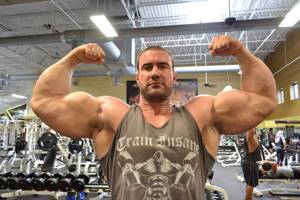
Sequence of exercises
Remember once and for all: WE START WITH heavy basic exercises and end with lighter ones - secondary (isolating exercises).
FOR BICEPS (CONDITIONALLY BASIC ARE):
- Standing biceps curl
- Standing dumbbell curl for biceps with supination
- Reverse grip barbell curl
- Hammer curls with dumbbells
Minor:
- Concentrated bicep curls
- The Larry Scott bench with a barbell or the exercise stand or shos is similar to the Larry Scott bench only with a block
FOR TRICEPS, the main basic exercises are:
- close grip press
- bars
Minor:
- French barbell presses
- extension at a vertical block (although with the proper execution style, it can be considered basic)
We create the most effective training programs
PS I forgot to tell you about one very effective technique for pumping up your arms! Its essence is simple, we will alternate exercises that are antagonistic to BICEPS and TRICEPS! Those. it will look like this:
- Basic biceps exercise 4x6-12
- Basic triceps exercise 4x6-12
- Basic biceps 4x6-12
- Basic triceps 4x 6-12
Do you see this alternation? First comes the biceps, then the triceps, then the biceps again, etc. This is a very effective trick that you should definitely use! By the way, always start your workout with biceps, followed by triceps. Otherwise, if you start with the triceps, it will limit the strength in the biceps curls.
Basically, this rule applies at the initial stage for beginners and intermediate levels of training, more advanced (experienced) look at the situation (because for the advanced, starting training with triceps is a chance to give at least some unfamiliar stress in order to trigger growth.

And this is the training program:
- Barbell curl for biceps, standing 4x6-12
- Barbell bench press with close grip 4x6-12
- Hammer Curls" (HAMMERS with standing dumbbells) 4x6-12
- Dips (emphasis on triceps) 4x6-12
That's all. THIS IS THE MAXIMUM EFFECTIVE COMPLEX FOR THE RAPID GROWTH OF ARM MUSCLE MASS. Nothing more is needed! I personally train according to this scheme, and I’m happy with the results.
For more advanced athletes the scheme is as follows
- Barbell curl for biceps 4x6-12
- Bars (triceps emphasis) 4x6-12
- Lifting the barbell with a reverse grip 4x6-12
- Close grip barbell press 4x6-12
- Lifting dumbbells for biceps, standing 3-4x6-12
- French bench press 4x6-12
Don't forget that any workout should last no more than 45 minutes. This is worth considering constantly!
Friends, support our group on Facebook, share this post with your friends or click the “Like” button! and you will always be aware of the latest news from the “Duty Rocking Chair”!
For you, we collect the best workouts, recommendations for proper nutrition and, of course, humor from the world of beautiful, energetic and healthy people - like you and me!
Source
Wrist curls
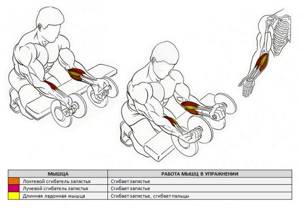
This forearm exercise targets the flexor carpi ulnaris, flexor carpi radialis, and palmaris muscles. A formative exercise, used to thicken the inner part of the forearm. Recommended for everyone, from beginner to experienced athlete to complete their biceps workout.
Exercise technique
1. Take dumbbells of the desired weight. Kneel in front of a bench and place your forearms across it, palms up. Your wrists are behind the edge of the bench. 2. In the starting position, your shoulders are straightened, your back is straight. The body and forearms are motionless until the end of the approach. Wrists extended, dumbbells hanging from fingers. 3. Take a deep breath and, holding your breath, bend your wrists as high as possible. At the top point, the hand is closed, the dumbbell is clenched in the fist. 4. You can exhale after overcoming the most difficult section of the amplitude. Then, without delay, immediately, slowly return your wrists to their original position and unclench your hand. 5. At the moment when the dumbbells reach the bottom point, do not linger and change the direction of their movement back up.
Technique tips
- Throughout the entire approach, do not lift your forearms off the bench. As soon as this happens, the biceps take on most of the load.
- In the starting position, the wrists should be extended beyond the edge of the bench far enough so that the dumbbells do not touch the bench throughout the entire range of motion.
- In the starting position, keep your grip as open as possible so that the dumbbell is literally held on your fingers. This will significantly increase the range of motion of the dumbbell.
- At the same time, a dumbbell tightly grasped in the hand will move through a significantly shortened amplitude, which will greatly reduce the effectiveness of the exercise.
- A variation of the exercise with a barbell is possible. However, it is less preferable because it limits the natural rotation of the wrists compared to dumbbells.
Wrist extensions
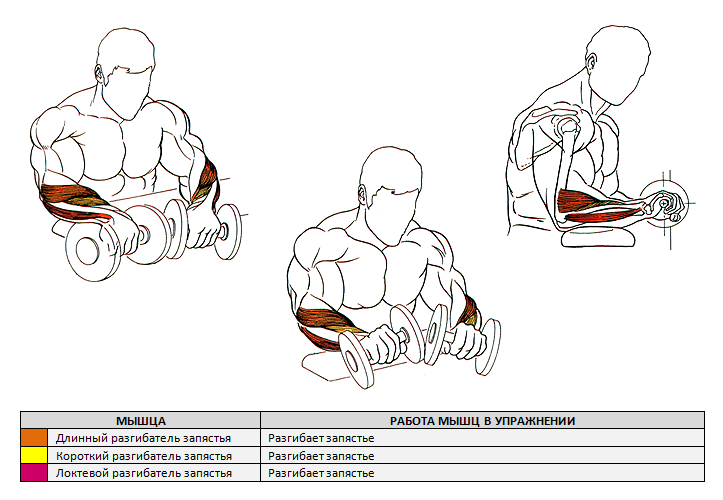
This forearm exercise targets the extensor carpi ulnaris, extensor carpi longus, and extensor carpi brevis muscles. A formative exercise, used to thicken the outer part of the forearm. Recommended for everyone, from beginner to experienced athlete to complete their biceps workout.
Exercise technique
1. Take dumbbells of the desired weight. Kneel in front of a bench and place your forearms across it, palms down. Your wrists are behind the edge of the bench. 2. In the starting position, your shoulders are straightened, your back is straight. The body and forearms are motionless until the end of the approach. Wrists down, dumbbells held on fingers. 3. Take a deep breath and, holding your breath, bend your wrists as high as possible. At the top point, the hand is closed, the dumbbell is clenched in the fist. 4. You can exhale after overcoming the most difficult section of the amplitude. Then, without delay, immediately, slowly return your wrists to their original position and unclench your hand. 5. At the moment when the dumbbells reach the bottom point, do not linger and change the direction of their movement back up.
Technique tips
- Throughout the entire approach, do not lift your forearms off the bench. Once this happens, the biceps and brachioradialis muscles take on most of the load.
- In the starting position, the wrists should be extended beyond the edge of the bench far enough so that the dumbbells do not touch the bench throughout the entire range of motion.
- In the starting position, keep your grip as open as possible so that the dumbbell is literally held on your fingers. This will significantly increase the range of motion of the dumbbell.
- At the same time, a dumbbell tightly grasped in the hand will move through a significantly shortened amplitude, which will greatly reduce the effectiveness of the exercise.
- A variation of the exercise with a barbell is possible. However, it is less preferable because it limits the natural rotation of the wrists compared to dumbbells.
Rotations of the arms at the forearm

This exercise for the forearm muscles involves the biceps, brachioradialis, and pronator carpi muscles. A formative exercise, used to thicken the outer and inner parts of the forearm. Recommended for everyone at the end of a biceps workout.
Exercise technique
1. Collect the required weight on the pendulum. Kneel in front of the bench and place the forearm of your working hand across it. The wrist is behind the edge of the bench. 2. In the starting position, your shoulders are straightened, your back is straight. The body is motionless until the end of the approach. The working hand holds the pendulum by the lower edge of the handle in a vertical position, the second hand rests on the bench. 3. Take a deep breath and, holding your breath, rotate your forearm with the pendulum outward (supination) so that it assumes a horizontal position. 4. As soon as the lowest point is reached, immediately, slowly return the pendulum to the vertical position. 5. You can exhale after overcoming the most difficult section of the amplitude. 6. At the moment when the pendulum returns to the top point, also do not linger. Inhale again, hold your breath and smoothly rotate the handle inward (pronation) until it reaches a horizontal position. 7. Perform the prescribed number of repetitions on one arm, then on the other. This will be one approach.
Technique tips
- Throughout the entire approach, do not lift your forearm off the bench. Once this happens, the biceps, brachialis and brachioradialis muscles take on most of the load.
- In the starting position, the wrist should be extended beyond the edge of the bench far enough so that at the lower points of the amplitude of movement, the pendulum does not touch the bench.
- There is no point in using too much weight in the exercise. It will prevent you from rotating your forearm through its full range of motion, which will significantly reduce the effectiveness of the exercise.
- However, too much weight at the bottom of the exercise can put excessive force on the wrist and dislocate the arm at the elbow.
- A variation of the exercise with a collapsible dumbbell is possible. Having collected the necessary weight at only one end, it will serve as an excellent replacement for a pendulum.
Afterword
At the beginning of the article, we set out to describe a set of biceps exercises. And now, we can confidently say that in this article we have reviewed perhaps the most effective biceps exercises in the gym. The list of exercises given here could be called the most complete if it were not constantly supplemented with new ones, with different equipment, with modified exercise techniques and more. The exercises given here for the biceps muscles are more than enough to constantly change training programs and add variety to the training process, regardless of your goals.
